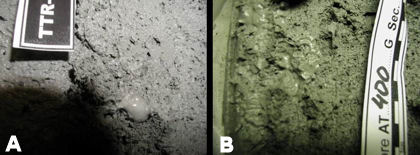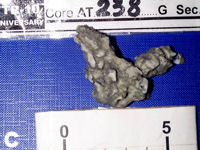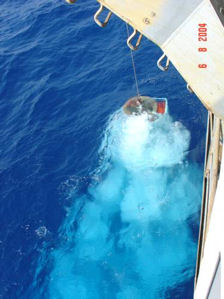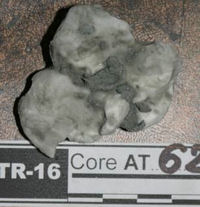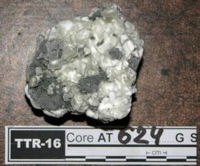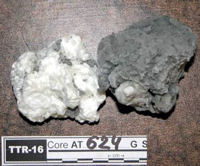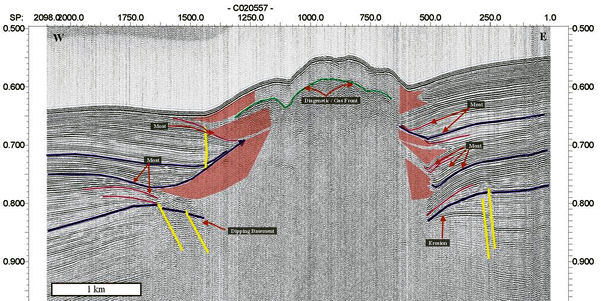
Tectonic control, deep crustal structure and fluid escape pathways in the Gulf of Cadiz Mud Volcano Field ( 01-LEC-EMA24F)
|
MvSeis
|
|
Euromargins Eurocores
|
|
Research Team
|
|
Research Cruises
|
|
Mud Volcanoes
|
|
Authigenic Carbonates
|
|
Gas Hydrates & composition
|
|
Cold Water Corals
|
|
Associated ecossystems
|
|
Publications
|
|
Mud Volcanoes Provinces in the World
|
|
Contacts
|


Gas
Hydrates
Gas hydrates have been recovered until present from 3 mud volcanoes in the
Gulf of Cadiz:
Ginsburg, Bonjardim and Captain Arutyunov (Figs. 1, 2 and 3). Evidence of the presence of gas
hydrates has been found in other mud volcanoes, in particular those from the
Deep Portuguese Mud Volcano Field. The
composition of the gas from the gas hydrates indicates a thermogenic origin
which suggests the possible existence of oil fields at depth (Mazurenko et
al., 2002).
|
|
|
Figure 1. Gas hydrates from the Gulf of Cadiz. (A and B) Gas hydrate dissociation in one core from the Captain Arutyunov mud volcano (TTR-12). (C) Gas hydrates retrieved from the Ginsburg mud volcano during the TTR-10 cruise (1999). |
Extensive gas hydrate dissociation has also been found when sampling with a TV-controlled grab, just when the grab reaches the sea surface (Fig. 2). The gas hydrate composition shows a clear thermogenic signature, indicating the presence of oil reservoirs at depth. Often more than 12-15% C2+ hydrocarbons have been found (Mazurenko et al., 2002).
|
|
| Figure 2: Gas hydrate dissociation of a TV-controlled grab sampling from Capt. Arutyunov mud volcano, Gulf of Cadiz, during the MVSEIS cruise TTR-14. |
Recently, during the TTR-16 MVSEIS research cruise, in July 2006, several samples of gas hydrates were recovered from the Bonjardim mud volcano (Fig. 3).
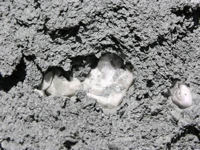 |
|
Figure 3a: Gas hydrates recovered from the Bonjardim mud volcano during the TTR-16 cruise, in July 2006. |
|
|
|
Figure 3b: Gas hydrates recovered from the Bonjardim mud volcano during the TTR-16 cruise, in July 2006. |
Shallow gas hydrates have also been inferred from geophysical data over the Mercator mud volcano (DePreiter et al. 2005). A anomalous reflection, identified as the base of a gas hydrate stability zone, was observed at the Mercator mud volcano in a water depth of about 400 m (Fig. 4). This interpretation was supported by the fact that gas hydrate stability modelling with reported thermogenic gas compositions, indicated that gas hydrates can be stable at this shallow location. BSR-inferred heat flow showed a concentric heat flow pattern around the crater, with a very sharp rise near the crater, consistent with the interpretation that the gas hydrate layer is affected by a focused flow of warm fluid in the crater. Modelled heat flow values near the crater edge run-up to 1100 mW m-2 and must be still higher inside the crater (DePreiter et al. 2005).
|
|
|
Figure 4: High-resolution seismic section across Mercator mud volcano shows stacked mud flow deposits (in red) around the mud volcano cone. A bottom simulating reflection at the top of the mud volcano (in green) indicates the base of the gas hydrate layer. (from Depreiter et al. 2005) |
Last Update 13-02-2008 Webmaster
